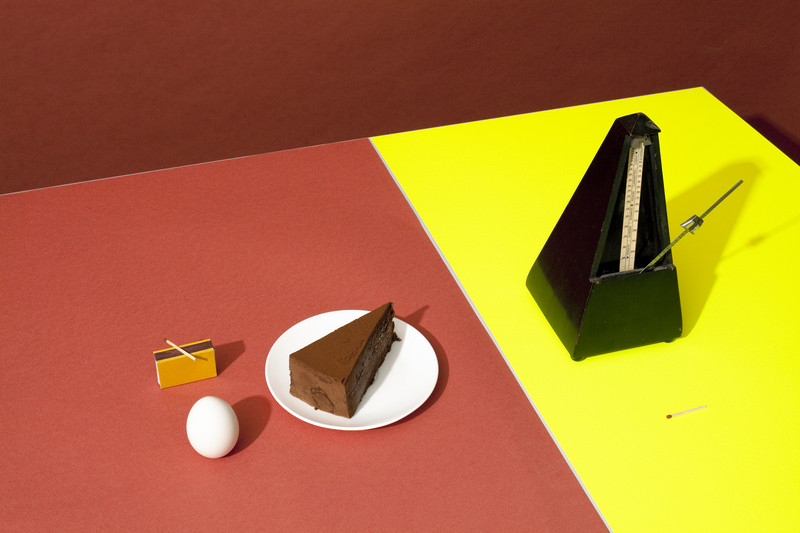Uta Eisenreich
07 Apr - 19 May 2012
UTA EISENREICH
Time after Sometimes
7 April - 19 May, 2012
Ellen de Bruijne PROJECTS presents Uta Eisenreich’s Tonbildschau Time after Sometimes (2012). Eisenreich develops a language of objects, which can be seen as a modern set of hieroglyphs, consisting of pictograms that convey meaning through their pictorial resemblance to a physical object and can visualizes a word, morpheme or sound.
The installation touches on major themes like love, time and transitoriness of human existence. Reminiscent of 17th century vanitas paintings Time after Sometimes features objects rich in morbid symbolism such as earthworms, insects, bones and chocolate cake. With a sense of humor that borders on idiocy Eisenreich explores the potential of a composition to become a script and the potential of a script to generate a composition. Objects are linked to sounds and pictures become an exercise in writing.
Time after Sometimes can be considered as a succession of Vocabulary (2005), where words were translated into images in an installation consisting of tableaus of strictly arranged clusters of numbered objects. Eisenreich concentrated on our means of understanding reality; in particular language, through the process of morphology. Whilst Vocabulary was translating words into images, Time after Sometimes reflects on the way our thoughts are structured, on Syntax. So here the principles and processes by which sentences are constructed are examined.
The work points out the arbitrary relationship (and structural differences) of language as a system of symbols and the mechanisms of the real world. Eisenreich’s work revolves around meaning, function and strategies about arrangement. She is fascinated by bringing order in the incoherent reality which surpasses the boundaries of our imagination.
Language can be compared to a sheet of paper: thought is one side of the sheet and sound is on the reverse side. Just as it is impossible to take a pair of scissors and cut one side of the paper without at the same time cutting the other, so it is impossible in a language to isolate sound from thought or thought from sound. Ferdinand de Saussure, in: ‘Course in General Linguistics’, (org. 1916)
Time after Sometimes is developed with the help of long time collaborator Julia Born.
Voice: Michael Blass
Sound mixing: Bart van Popplel
Video editing: Rens Christiaansen
Assistance: Renee de Groot
Time after Sometimes
7 April - 19 May, 2012
Ellen de Bruijne PROJECTS presents Uta Eisenreich’s Tonbildschau Time after Sometimes (2012). Eisenreich develops a language of objects, which can be seen as a modern set of hieroglyphs, consisting of pictograms that convey meaning through their pictorial resemblance to a physical object and can visualizes a word, morpheme or sound.
The installation touches on major themes like love, time and transitoriness of human existence. Reminiscent of 17th century vanitas paintings Time after Sometimes features objects rich in morbid symbolism such as earthworms, insects, bones and chocolate cake. With a sense of humor that borders on idiocy Eisenreich explores the potential of a composition to become a script and the potential of a script to generate a composition. Objects are linked to sounds and pictures become an exercise in writing.
Time after Sometimes can be considered as a succession of Vocabulary (2005), where words were translated into images in an installation consisting of tableaus of strictly arranged clusters of numbered objects. Eisenreich concentrated on our means of understanding reality; in particular language, through the process of morphology. Whilst Vocabulary was translating words into images, Time after Sometimes reflects on the way our thoughts are structured, on Syntax. So here the principles and processes by which sentences are constructed are examined.
The work points out the arbitrary relationship (and structural differences) of language as a system of symbols and the mechanisms of the real world. Eisenreich’s work revolves around meaning, function and strategies about arrangement. She is fascinated by bringing order in the incoherent reality which surpasses the boundaries of our imagination.
Language can be compared to a sheet of paper: thought is one side of the sheet and sound is on the reverse side. Just as it is impossible to take a pair of scissors and cut one side of the paper without at the same time cutting the other, so it is impossible in a language to isolate sound from thought or thought from sound. Ferdinand de Saussure, in: ‘Course in General Linguistics’, (org. 1916)
Time after Sometimes is developed with the help of long time collaborator Julia Born.
Voice: Michael Blass
Sound mixing: Bart van Popplel
Video editing: Rens Christiaansen
Assistance: Renee de Groot

